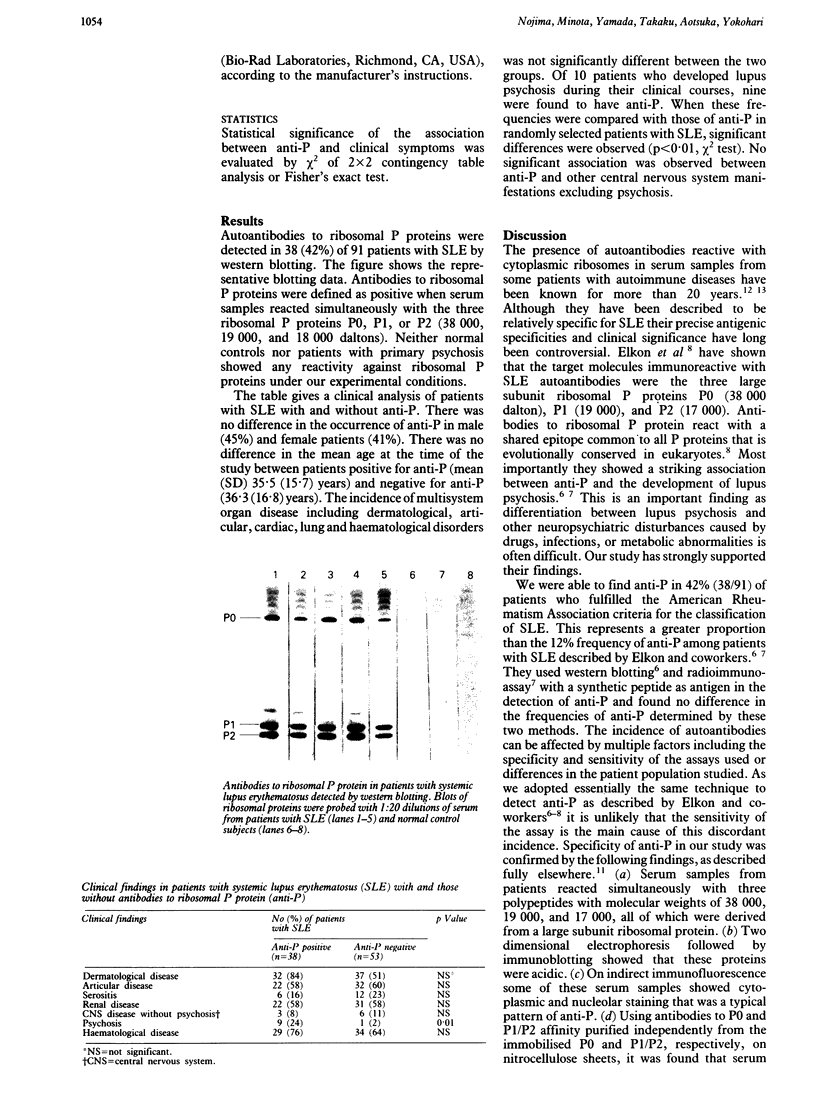Abstract
Ninety one Japanese patients with systemic lupus erythematosus (SLE) were studied to determine the clinical significance of antibodies to ribosomal P protein (anti-P). Anti-P was detected by western blotting in 38 of 91 patients (42%). Clinical symptoms of SLE were compared between patients with and without anti-P. The occurrence of lupus psychosis was significantly higher in patients with anti-P than in those without anti-P (9/38 v 1/53). No significant association was found between anti-P and other symptoms of SLE. These data strongly support the suggestion proposed by previous workers that anti-P is a marker autoantibody for the development of lupus psychosis.
Full text
PDF


Images in this article
Selected References
These references are in PubMed. This may not be the complete list of references from this article.
- Bluestein H. G. Neurocytotoxic antibodies in serum of patients with systemic lupus erythematosus. Proc Natl Acad Sci U S A. 1978 Aug;75(8):3965–3969. doi: 10.1073/pnas.75.8.3965. [DOI] [PMC free article] [PubMed] [Google Scholar]
- Bonfa E., Elkon K. B. Clinical and serologic associations of the antiribosomal P protein antibody. Arthritis Rheum. 1986 Aug;29(8):981–985. doi: 10.1002/art.1780290806. [DOI] [PubMed] [Google Scholar]
- Bonfa E., Golombek S. J., Kaufman L. D., Skelly S., Weissbach H., Brot N., Elkon K. B. Association between lupus psychosis and anti-ribosomal P protein antibodies. N Engl J Med. 1987 Jul 30;317(5):265–271. doi: 10.1056/NEJM198707303170503. [DOI] [PubMed] [Google Scholar]
- Elkon K. B., Parnassa A. P., Foster C. L. Lupus autoantibodies target ribosomal P proteins. J Exp Med. 1985 Aug 1;162(2):459–471. doi: 10.1084/jem.162.2.459. [DOI] [PMC free article] [PubMed] [Google Scholar]
- Estes D., Christian C. L. The natural history of systemic lupus erythematosus by prospective analysis. Medicine (Baltimore) 1971 Mar;50(2):85–95. doi: 10.1097/00005792-197103000-00001. [DOI] [PubMed] [Google Scholar]
- Gibson T., Myers A. R. Nervous system involvement in systemic lupus erythematosus. Ann Rheum Dis. 1975 Oct;35(5):398–406. doi: 10.1136/ard.35.5.398. [DOI] [PMC free article] [PubMed] [Google Scholar]
- Golombek S. J., Graus F., Elkon K. B. Autoantibodies in the cerebrospinal fluid of patients with systemic lupus erythematosus. Arthritis Rheum. 1986 Sep;29(9):1090–1097. doi: 10.1002/art.1780290906. [DOI] [PubMed] [Google Scholar]
- How A., Dent P. B., Liao S. K., Denburg J. A. Antineuronal antibodies in neuropsychiatric systemic lupus erythematosus. Arthritis Rheum. 1985 Jul;28(7):789–795. doi: 10.1002/art.1780280710. [DOI] [PubMed] [Google Scholar]
- Laemmli U. K. Cleavage of structural proteins during the assembly of the head of bacteriophage T4. Nature. 1970 Aug 15;227(5259):680–685. doi: 10.1038/227680a0. [DOI] [PubMed] [Google Scholar]
- Nojima Y., Minota S., Yamada A., Takaku F. Identification of an acidic ribosomal protein reactive with anti-Sm autoantibody. J Immunol. 1989 Sep 15;143(6):1915–1920. [PubMed] [Google Scholar]
- Tan E. M., Cohen A. S., Fries J. F., Masi A. T., McShane D. J., Rothfield N. F., Schaller J. G., Talal N., Winchester R. J. The 1982 revised criteria for the classification of systemic lupus erythematosus. Arthritis Rheum. 1982 Nov;25(11):1271–1277. doi: 10.1002/art.1780251101. [DOI] [PubMed] [Google Scholar]
- Wilson H. A., Winfield J. B., Lahita R. G., Koffler D. Association of IgG anti-brain antibodies with central nervous system dysfunction in systemic lupus erythematosus. Arthritis Rheum. 1979 May;22(5):458–462. doi: 10.1002/art.1780220504. [DOI] [PubMed] [Google Scholar]



